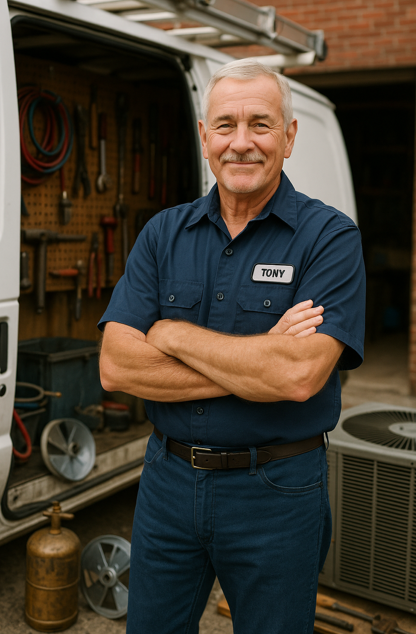What’s the Big Deal with R-32 Gas Furnaces? Tony Explains 🔥🔍
Alright, so you’re thinking about upgrading your home heating system with an 80,000 BTU R-32 gas furnace. That’s a solid choice, but what makes R-32 so special anyway?
R-32 is the next-generation refrigerant gaining traction in HVAC for its lower environmental impact and efficiency gains. While gas furnaces don’t use refrigerant directly (they burn gas for heat), pairing your furnace with R-32-based air conditioners or heat pumps creates a super-efficient system.
Here’s the scoop: R-32 refrigerant has a Global Warming Potential (GWP) about 66% lower than R-410A, the older refrigerant commonly used. That means less environmental impact and often better performance in cooling and heating cycles.
The Environmental Protection Agency (EPA) recognizes R-32 as a safer, more climate-friendly option — something future-proof and increasingly standard in modern HVAC systems.
How Does an 80,000 BTU Gas Furnace Fit In? 🔥
Your gas furnace, especially an 80,000 BTU model, handles the heating side of the equation by burning natural gas to warm your home. It works seamlessly with your cooling system, which may be using R-32 refrigerant for air conditioning or heat pump functions.
By combining an R-32 AC/heat pump with an efficient gas furnace, you get a hybrid system that optimizes energy use year-round. During milder days, the heat pump handles heating efficiently. When temps drop low, the gas furnace kicks in for powerful warmth.
The Department of Energy’s Energy Saver guide recommends hybrid systems for maximizing efficiency and cutting costs — especially in regions with cold winters.
Efficiency Ratings to Watch: AFUE and Beyond 📊✅
When shopping for your 80,000 BTU R-32 gas furnace, don’t just eyeball the BTUs — look at the AFUE rating, which stands for Annual Fuel Utilization Efficiency.
An AFUE of 80% means 80 cents of every dollar spent on gas turns into heat — the rest escapes through exhaust. Modern high-efficiency furnaces can hit 95% or more.
R-32 systems typically pair well with mid to high AFUE furnaces (80%+), balancing upfront cost with fuel savings. The Consortium for Energy Efficiency (CEE) tracks these standards and offers rebates and incentives for high-efficiency equipment, so keep an eye out!
Real-World Savings: What You Can Expect 💸📉
Let’s talk money. How much can you actually save with an R-32 compatible furnace?
-
Lower refrigerant GWP means your cooling system uses energy more efficiently, lowering electricity bills.
-
A properly sized 80,000 BTU gas furnace running at 80% AFUE or higher will cost less to operate than an older, inefficient model.
-
Combined with proper insulation and a sealed duct system, these upgrades can reduce heating bills by up to 20-30%.
According to the U.S. Department of Energy, simple efficiency improvements often pay for themselves in just a few years through lower energy costs.
Tony’s Top Tips to Maximize Efficiency with Your New Furnace ⚙️💡
Getting the most out of your R-32 gas furnace system isn’t just about the equipment — it’s how you maintain and operate it.
-
Regular Maintenance: Change air filters every 1–3 months and schedule annual tune-ups. This keeps your furnace running smoothly and prevents efficiency drops.
-
Smart Thermostats: Install programmable or smart thermostats to reduce heating when you’re away or asleep. These can trim bills up to 10%!
-
Seal & Insulate Ducts: Leaky ducts waste 20-30% of your heated air. Seal joints with mastic or foil tape and insulate exposed ducts to keep warmth inside your home.
-
Zone Heating: If your furnace supports it, use zone controls to heat only occupied rooms, saving energy on unused spaces.
The ENERGY STAR program has tons of resources to help homeowners optimize furnace performance.
Why R-32 Is the Smarter Refrigerant Choice for Today and Tomorrow 🌎✨
Beyond cost savings, R-32 represents a push toward sustainable HVAC. With its low GWP and high energy efficiency, R-32 helps reduce the carbon footprint of your home’s heating and cooling.
Many countries have already mandated the phase-out of high-GWP refrigerants like R-410A — the U.S. is catching up fast. According to the International Energy Agency (IEA), switching to refrigerants like R-32 is key to meeting climate goals.
Choosing an R-32 compatible system today is investing in a more sustainable, future-ready home.
The Installation Angle: Don’t Skimp on the Pro’s Touch! 👨🔧
We’ve talked efficiency, but remember: installation matters. Even the best furnace and R-32 AC won’t perform if installed poorly.
Make sure your HVAC contractor is trained and certified in handling R-32 refrigerants, which require special safety measures. The Environmental Protection Agency’s Section 608 certification is a must for techs working with refrigerants.
Proper installation means:
-
Correct refrigerant charge
-
Leak testing and evacuation
-
Proper airflow and ductwork balance
That’s how you get the promised savings and reliability.
Frequently Asked Questions About R-32 Gas Furnaces — Tony Answers 💬❓
Q: Can I use my old furnace with a new R-32 AC?
A: It’s possible, but you’ll want to check compatibility and refrigerant lines carefully. An expert can advise if retrofit or full replacement makes more sense.
Q: Is R-32 safe in homes?
A: Yes, it’s classified as mildly flammable, but when handled by certified pros with the right equipment, it’s safe and effective.
Q: Will my utility company offer rebates for R-32 systems?
A: Many do! Check with your local utility and look for ENERGY STAR incentives.
Wrapping Up — Tony’s Bottom Line on R-32 Gas Furnace Efficiency 🔥📈
If you want to cut heating costs, reduce your carbon footprint, and enjoy reliable warmth, an 80,000 BTU R-32 gas furnace combined with an R-32 compatible cooling system is a winning strategy.
Remember, efficiency isn’t just a number — it’s about the right equipment, proper installation, and smart operation.
Stick with trusted brands, certified installers, and regular maintenance — and you’ll keep your home cozy without breaking the bank.
🛠️ From my toolbelt to your thermostat, stay comfortable — Tony 🛠️







